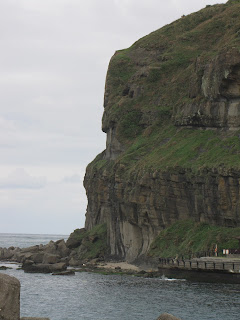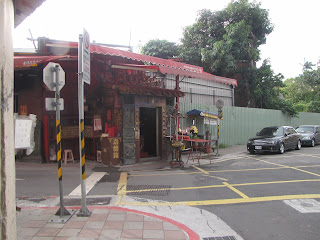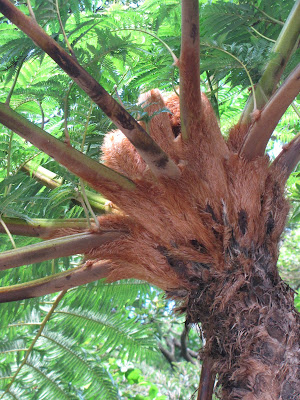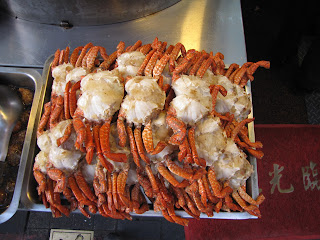December 28
We had scheduled an afternoon bus tour for Friday for the Northeast cost of Taiwan and the mountain village of Jiufen. So in the morning we took Theo to a nearby park.
Our tour began at a coastal rock formation that our guide Danny said was called "Nose." He had to draw a picture for us to figure out how to see the nose. In the opposite direction were some coastal mountains and offshore rock islands.
There was a small temple near where we stopped and Danny had walked over there. George joined him and asked about it. He said it was a Taoist temple and sailors came there to pray that they would have safe sea journeys.
The center of the temple roof featured three figures; he said they are (l to r) longevity, prosperity, and happiness.
The corner of the roof was interesting, as well.
A temple across the bay featured the same three figures on its roof and we noticed them on many temples in Taiwan from then on.
A few steps away we walked on and around some amazing sandstone formations on the ocean coast.
Then we started a steep bus climb into the mountains to the village of Jiufen.
We saw a number of cemeteries on the tour. The graves looked like small houses.
The exciting part of the tour was a one-hour walk down a narrow shopping street in Jiufen. Danny (on the left with the cap in the photo below) gave us our instructions -- stay on the narrow street, head toward shop number 116, be there in one hour to get the bus back to Taipei -- and have fun.
It was a narrow street with many interesting things to see.
We stopped for lunch at a tea house one story above the bustling street.
When we got to shop number 116, we thought we had a short, uninteresting walk to the bus, but that turned out not to be the case. Danny directed us off to a great overview of northern Taiwan and the ocean.

When we turned back around, the view of Jiufen was beautiful.
The view back of the path we'd taken down was also beautiful. It had been a great tour.
December 29
Saturday turned out to be a beautiful day so we decided to take the Metro and a bus to Yangmingshan National Park, a large park directly north of Taipei. But first Mary, Riley, and I walked to our nearby Cama Cafe, a great coffee shop, to get our morning coffee drinks. George noticed for the first time a little temple a half block from the coffee shop at a small intersection. Many of the temples seem to be places for brief prayers and meditations rather than places for large communal ceremonies.
We have read reports that Taiwan is the most biologically diverse country in the world per unit of area, and Yangmingshan Park is a contributor to that record -- the region reportedly has, for example, 168 different species of butterflies (although December is not a good viewing time) and 122 species of birds. We did a lot of hiking that day and saw some beautiful foliage.


Most of the hiking was on the sides of mountains and we had some great views into the land below.
The highlight of the trip to Yangmingshan for Mary and George and one of the top highlights of the whole trip to Taipei was our encounter with a Taiwan Barbet (Megalaima nuchalis), a beautiful bird with a very colorful face, known as "5-color bird" in Chinese. We first heard a bird warbling and it sounded nearby. We waited and watched and finally spotted it high in a nearby tree. Thanks to George's 20x zoom, we got some great pictures. We didn't know what it was but showed the pictures to some Taiwanese "birders" near the end of our visit to the park and they recognized it right away and told us how lucky we had been to see it -- they have been looking to see one for a long time without success. We felt very lucky. The Chinese say that its call resembles that of a percussion instrument known as a wooden fish. This instrument is used in monasteries during rituals involving the recitation of sutras, mantras and Buddhist texts. In Buddhism the fish, which never sleeps, symbolizes wakefulness and therefore reminds the chanting monks to concentrate on their sutra. To hear the Taiwan Barbet, go to: http://www.xeno-canto.org/species/Megalaima-nuchalis?&view=3

Mary found two heart patterns made of camellia blooms off the trail.
Some of the ascents and descents were serious, but we all persevered.
Mary loves moss and lichen.
We saw some fall leaves.
And, even though it wasn't the best butterfly viewing season, we saw a beautiful example of one of the species that lives in the park.
Temples can be found in the most unusual places.
Strangers fell in love with Theo and wanted their pictures taken with him; Grandpa got his camera in on one of the photo shoots. And, back in Papa's arms, Theo applauded his new friends.
Grandma and Grandpa were happy to take their turn with Theo.
On our way out of the park, we got another moment of avian excitement when, thanks to some Thai birders that had already spotted it and called our attention to it, we saw a Crested Serpent Eagle. They are found in forested habitats across tropical Asia. They often feed on snakes, giving them their name. We had seen one in captivity at the zoo on Christmas Day; it was very exciting to see this one free.
A vendor was selling Taiwanese purple sweet potatoes. Mary and George had heard of these and tasted some at lunch at a nice cafe the afternoon before Riley, Joel, and Theo arrived -- they were very tasty!
Theo played some peek-a-boo hat tricks.
Next, a stop at the Shilin Night Market:

Finally, a Metro ride back to the hotel. Note the markings on the platform -- a waiting line, and lines indicating how riders are to queue. Taiwanese Metro riders obey those lines; so did we.
December 30
The weather is changeable in Taiwan: Sunday was cold, rainy, and gray -- a perfect day to visit the National Palace Museum, as half the population of Taipei seemed to have concluded, judging by the crowds. The museum was originally founded in 1925 in the Forbidden City in Beijing. In 1949, with civil war raging, the Republic of China shipped about 600,000 objects in the collection to Taiwan.
Interior photography is prohibited, so we are borrowing one photo from the Museum website. The vase dates to 4200-2600 BC (imagine that!).
Mary found black swans in a garden before we left.
New Year's Eve
Monday was still cold and gray, but there was no rain. We took the Metro to near Taipei 101 and walked the rest of the way.
George did a little research and found out that the "tallest building" measure is more complicated than he thought, but it sounds like Taipei 101 (1,667 feet from ground to highest architectural structure and with 101 floors above ground and 5 below) was the tallest inhabited building from its opening in 2004 until 2010, when the Burj Khalifa in Dubai opened. It also won recognition in 2011 as the largest green building in the world. It was built at a cost of $1.7 billion (US).
According to Wikipedia, the height of 101 floors commemorates the renewal of time: the new century that arrived as the tower was built (100+1) and all the new years that follow (January 1 = 1-01). It symbolizes high ideals by going one better on 100, a traditional number of perfection.
Taipei 101 was designed to withstand typhoons and earthquake tremors common in its area of the Pacific. Note to readers: George got a little caught up in his research and found the construction to achieve those goals very interesting and is going to provide edited information from Wikipedia below. Please skip the purple paragraphs if you're not interested.
The design achieves both strength and flexibility for the tower through the use of high-performance steel construction. Thirty-six columns support Taipei 101, including eight "mega-columns" packed with 10,000 psi (69 MPa) concrete. Every eight floors, outrigger trusses connect the columns in the building's core to those on the exterior.
These features combine with the solidity of its foundation to make Taipei 101 one of the most stable buildings ever constructed. The foundation is reinforced by 380 piles driven 80 m (262 ft) into the ground, extending as far as 30 m (98 ft) into the bedrock. The stability of the design became evident during construction when, on March 31, 2002, a 6.8-magnitude earthquake rocked Taipei. The tremor was strong enough to topple two construction cranes from the 56th floor, then the highest. Five people died in the accident, but an inspection showed no structural damage to the building, and construction soon resumed.
The building was designed with a 660 tonnes (728 short tons) steel pendulum that serves as a tuned mass damper, at a cost of US$4 million. Suspended from the 92nd to the 87th floor, the pendulum sways to offset movements in the building caused by strong gusts. Another two tuned mass dampers, each weighing 6 tonnes (7 short tons), sit at the tip of the spire. These prevent damage to the structure due to strong wind loads.
Back to the main narrative. These are the views as we approached the tower. We can't read Chinese, but believe the big poster is about that evening's New Year's Eve celebration in the vicinity of Taipei 101.
A fancy, multi-level shopping mall adjoins the tower and that's where we headed.
A juggling clown was entertaining a crowd in the mall and Theo and Grandpa enjoyed that.
After a visit to a toy store and book store and a terrific lunch at Sweet Tea, we left Taipei 101 and headed for the Longshan Temple, which is (to quote a tourist brochure) "a bastion for traditional and folk religious beliefs."
It was built in 1738 by settlers from Fujian, China. According to Lonely Planet, "As the story goes, a passer-by left an amulet of the Buddhist Goddess of Mercy Guanyin hanging on a tree on the site of the present temple, and the amulet shone so brightly, even after dark, that all who passed by knew the site was blessed. Nearly three centuries later, the spot still exudes a certain warmth." The temple has been destroyed several times including by American bombers trying to destroy Japanese armaments during WW II. Taipei residents have consistently rebuilt and renovated it.
Like most temples in Taiwan, the temple worships a mixture of Buddhist, Taoist, and folk deities, including Matsu, the ancient goddess of the sea.
It has three decorated gates, one inside the next. In the first courtyard is a waterfall, a point of cleansing.
Worshippers bring food and gifts for the deities and leave them in the inner courtyard. According to a CNN story, those who bring food later eat it to imbibe the blessings it has absorbed. They light candles and incense, and pray.
There are altars honoring many different deities, including, in the first two pictures below, the goddess Matsu.

The place of honor in the main hall of the temple, however, goes to the goddess Guanyin, who, as noted above, is said to have inspired construction of the temple. In Chinese Buddhism, Guanyin represents the pinnacle of female and humanitarian values. The figure of Guanyin survived the WW II bombing, which destroyed the main hall of the temple. According to a brochure distributed at the temple, this is the "most famous manifestation of efficacy" of Longshan Temple. According to Wikipedia, some Buddhists believe that when one of their adherents departs from this world, they are placed by Guanyin in the heart of a lotus, and then sent to the western pure land of Sukhavati. She is accompanied by another two bodhisattvas, Manjusri and Samantabhadra (in the two smaller pictures below).


We've done a lot of traveling by Taipei's wonderful Metro system and Theo's become quite a straphanger.
Metro was getting pretty crowded at that point and extra Metro personnel were on duty to handle the crowds expected for the New Year's Eve celebration.
Theo helped Grandpa eat an apple before heading to bed.
Theo helped Grandpa eat an apple before heading to bed.
We didn't see it, but here's what Taipei 101 looked like during the celebration:
New Year's Day
It was rainy and cool on Tuesday and we'd met the tourist goals that Riley and Joel had set for ourselves so we hung around the hotel and ran a few errands to get ready to fly home the next day. Mary and Theo had a lot of fun with empty plastic water bottles.
Interesting Taiwan Factoids
Motorbikes: As in Thailand, there are very many motorbikes. That probably beats cars from an environmental perspective, but they do make it a little more difficult for pedestrians crossing streets and even walking on sidewalks since they come zooming down the sidewalk heading for a parking space on the sidewalk by the curb. At red lights in Taipei, motorbikes maneuver to the front of the waiting traffic and make quite a scene as they head out when the light changes. Here's a picture of motorbikes waiting for a green light (and motor bikes parked on the sidewalk):
Crossing Guards: In recognition of the risk they create (we think), we noticed that the city places crossing guards out when school kids are heading home. They step out and block traffic planning right turns (on red or green) while the pedestrians cross.
Money and Metro Cards: A US dollar is worth about 28 New Taiwan Dollars. That was convenient for Mary and George, who have had a few months to get used to a 30-1 exchange rate for Thai Bahts to US$: it made figuring the US-equivalent price a little easier since we were used to the calculation.
Up to 50 NT$, currency is coins; above that, it's bills. The faces most frequently seen on Taiwanese currency are Chiang Kai-shek and Sun Yat-sen. That's the Chiang Kai-shek in the (small denomination) coins in the picture below and Sun Yat-sen on the 100 NT$ bill.
The Metro system has a nice option for tourists -- an Easy Card. You buy it and put some money on it to begin and then reload it as you need. It provides a 20% discount off regular fares.
That's it. It was a great and interesting trip. We loved spending the time with Riley, Joel, and Theo. We missed Bud and Dave & Linda, but Bud had a fine holiday in Miami and Dave & Linda celebrated with family & friends in Burlington. We hope you have enjoyed these blog postings. Thanks for reading.























































































































Catching up on some of your older posts!
ReplyDeleteOh, George and Mary, your pictures give me little pangs of nostalgia, especially Jiuo Fun. We used to go there on rainy days, sit in out favourite teahouse, next to the window so we could enjoy the view and drink green tea and eat pistachios. Really nice memories! Thanks! I'm glad you had a good time!
And thank you, Rene, for your excellent suggestions about what to see and do in Taipei. We enjoyed Jiuo Fun (as you can tell from the blog) and your remark about sitting next to the tea house window and enjoying the view reminded me instantly of the photo above of our daughter and grandson -- I just love the photo and the view from the tea house window makes all the difference!
Delete